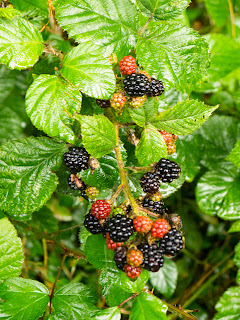Chevening, the picturesque small village north-east of Sevenoaks, is an ideal starting point for an autumn yomp along the North Downs Way and the wonderful surrounding countryside of the Kent - Surrey borders. There is of course the added bonus of the possibility of catching a fleeting glimpse of our hard working Foreign Secretary, who may be residing, at our expense, at his magnificent 17th-century grace and favour mansion reputedly designed by Inigo Jones and set in a rolling 3500 acre estate. If there is an official reception in full swing be sure to stick to the designated footpaths to avoid the risk of being wrestled to the ground by an over eager diplomatic protection officer, lurking in nearby bushes.
The early days of a heavy autumn when the temperatures are still mild and the grass verges are heavy with dew long into the afternoon are ideal for walking. Parking up at the back of the pretty St Botolph's church, a path leads north from the church before rising up about 100 meters to the top of the chalk downs. These days are the last for the blackberries and the first of the chestnuts though the full riotous colours of autumn are yet to reach their full glory. After an ascent through woods, the path intersects the North Downs Way and by turning left and heading west, Romney and I, both panting a little from the exertion, set off towards Surrey. The well signposted path is littered with copper coloured beech leaves and thousands of acorns crunch under my boots as Romney pursues pheasants in every field.
After almost 2km, the path crosses the road at Sunbridge Hill and if you are only looking for an hour or two of exercise you can turn left here, after the kissing gate and proceed downhill past Knockholt Lodge and then turn left past the pheasant hatchery into Park Wood. This will lead you back down through the Chevening Estate but you will need to keep dogs on leads near the hatchery as there are game birds everywhere.
For a dog with very limited cerebral capacity Romney is most studious when it comes to negotiating kissing gates. His first preference is to try and find a gap big enough to squeeze through but he gradually grows more confident at following me through the simple manoeuvre of opening the gate, sliding past and closing the gate behind us. In one field a gate was left standing isolated serving no purpose but Romney insisted on approaching it carefully and waiting patiently for me to open it for him even though there was a 20 meter gap either side of it for him to proceed through.
This beautiful countryside must be unchanged for a thousand years except for the height of the ancient oak trees and the distant hum of the M25 sounding the encroachment of modern humanity. Dense hedgerows are bursting with blackberries, rosehip, beech, ferns, holly and gorse. This wilderness is so close to London and if you glance up to the left as you approach Kent by car just after the Clacket's Lane services station on the M25, that is where we are.
Just west of Joelands Wood there is a conveniently placed seat fashioned from rough logs and after sharing a cheese sandwich with Romney he enjoys a sudden spontaneous ecstatic moment, writhing in the wet grass like a love sick puppy rather than a corpulent eleven year-old dog with chronic flatulence.
We leave the trackway after our sandwich and ecstatic moment and head north to try and make a circuit and follow a new sign that says Berry Green Circular Walk. This has been created by Bromley Council as a 7.5 mile walk starting at Cudham recreation ground. Tempted by the smart newsign, I realise we have left the North Downs Way a little too early and we pass an ostentatious newly built manor house and proceed over Grays Road into the curiously named Bombers Lane. The lane peters put into an attractive public footpath that proceeds through rolling woodland and fields to the Tally Ho pub.
Pubs always form part of the walking itinerary these days because they allow the old dog to have a well earned rest and the old walker to enjoy a decent Kentish ale which in this case was a superb Larkins Tradtional ale from the local brewery located at Chiddingstone. Only 3.4% ABV so no risk of a serious navigational failure on the homeward leg but it's a lovely smooth tawny treat all the same, nicely augmented by a bag of cheese and onion crisps. We are close to Chevening but there is probably little chance of meeting the Foreign Secretary holding court at the bar of the Tally Ho despite their good reputation for seafood. Instead a retired lady reads out extracts from this week's Sevenoaks Chronicle to her husband and discusses property prices in Cornwall with the landlord.
" A man tried a lure a schoolgirl into his car near Borough Green." she tells her husband and "Blimey, that Martin Clunes is looking his age."
Romney sleeps peacefully on the faded floral carpet, which given its age, could also have been designed by Inigo Jones, while I enjoy the ale and the unpretentious ambience before we head off down the Knockholt Road and back towards Chevening.


















